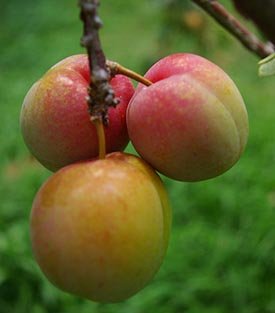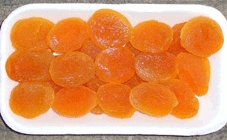Apricot Nutrition facts
Full of fragrance and sweet, golden-orange apricots are another summer delicacy of Asian origin. These much-prized fruits were first brought to Europe by Greeks, who named them as “golden eggs of the sun."
Botanically, the fruit is closely related to peaches and nectarine; sharing with them in the broader Rosaceae family of fruit-trees in the genus; Prunus. Scientific name: Prunus armenia.
Today, some of the main producing regions of this fruit are Turkey, Iran, Italy, France, Spain, Syria, Greece, and China.
 |
| Fresh apricots: ourtesy: Samuel Mann |
Apricot is a medium-sized deciduous tree that grows best in well-drained mountain slope soils. By spring, it bears plenty of beautiful pinkish-white flowers that attract bees.
They are almost uniform, 4-5 cm in diameter, and weigh about 35 g. In structure, an apricot is a drupe consisting of a centrally located single pit, surrounded by crunchy, aromatic edible flesh. The seed is enclosed in a hard stony shell often called "stone."
Fresh, ripe apricots have a sweet flavor similar to plums.
Sundried organic apricots are nutritiously denser than fresh ones, although they have less vitamin C content. Its seed kernel is also edible and tastes like that of almond nut. Oil extracted from these kernels is employed in cooking.
Health benefits of Apricots
Fresh fruits are low in calories, composing just 48 calories per 100 g weight. Nonetheless, they are an excellent source of dietary fiber, antioxidants, vitamins, and minerals.
Apricots are a good source of numerous health-promoting phytochemicals that help prevent heart disease, reduce LDL, ("bad cholesterol") levels, and offer protection against cancers.
Apricots are excellent sources of vitamin-A and carotenes. 100 grams of fresh fruits carry 1926 IU or 64% of the daily required levels of vitamin A. These compounds are known to have antioxidant properties and are essential for vision.
Vitamin A also required for maintaining healthy mucosa and skin. Consumption of natural fruits rich in carotenes helps protect the body from lung and oral cavity cancers.
Fresh fruits contain vitamin-C, another natural antioxidant. Vitamin C helps the human body develop resistance against infectious agents and scavenge harmful oxygen-free radicals.
They are also good sources of minerals such as potassium, iron, zinc, calcium, and manganese. Potassium is a heart-healthy mineral; an important component of cell and body fluids that help regulate heart rate and blood pressure.
The total antioxidant or ORAC value of fresh apricots is 1115 μmol TE/100 g. Most of this value is attributed to some important health-promoting flavonoid polyphenolic antioxidants such as lutein, zeaxanthin, and beta-cryptoxanthin. Altogether, these compounds act as protective scavengers against oxygen-derived free radicals and reactive oxygen species (ROS) that play a role in aging, cancers, and various disease processes.
Further, zeaxanthin, a carotenoid selectively concentrated in the retinal "macula lutea" in the human eyes is thought to provide antioxidant and protective UV light-filtering functions. Thus, the consumption of fruits rich in zeaxanthin helps the eyes protect from age-related macular disease (AMRD), especially in older adults.
| Principle | Nutrient Value | Percent of RDA |
|---|---|---|
| Energy | 48 Kcal | 2.5% |
| Carbohydrates | 11.12 g | 8.5% |
| Protein | 1.4 g | 2.5% |
| Total Fat | 0.4 g | 1% |
| Cholesterol | 0 mg | 0% |
| Dietary Fiber | 2 g | 5% |
| Vitamins | ||
| Folates | 9 μg | 2% |
| Niacin | 0.600 mg | 4% |
| Pantothenic acid | 0.240 mg | 5% |
| Pyridoxine | 0.054 mg | 5% |
| Riboflavin | 0.040 mg | 3% |
| Thiamin | 0.030 mg | 2.5% |
| Vitamin A | 1926 IU | 64% |
| Vitamin C | 10 mg | 16% |
| Vitamin E | 0 mg | 0% |
| Vitamin K | 3.3 µg | 3% |
| Electrolytes | ||
| Sodium | 1 mg | 0% |
| Potassium | 259 mg | 5.5% |
| Minerals | ||
| Calcium | 13 mg | 1.3% |
| Copper | ||
| Iron | 0.39 mg | 5% |
| Magnesium | 10 mg | 2.5% |
| Manganese | 0.077 mg | 3% |
| Phosphorus | 23 mg | 3% |
| Zinc | 0.2 mg | 2% |
| Phyto-nutrients | ||
| Carotene-α | 19 µg | -- |
| Carotene-ß | 1094 µg | -- |
| Crypto-xanthin-ß | 104 µg | -- |
| Lutein-zeaxanthin | 89 µg | -- |
Selection and storage

|
| Dried apricots. |
Apricot season lasts from May until September. Buy fresh, well-ripe, golden-orange color fruits that feature uniform size and a pleasant aroma.
Avoid those with pale yellow skin as they picked too early from the tree. Take care while handling ripe delicate fruits.
Store them in the refrigerator in an egg tray set at high relative humidity. Use apricots as early as possible.
Sundried apricots are equally famous as fresh fruits and can be readily available in markets worldwide.
Preparation and Serving method
Wash fresh fruits gently in cold water and pat dry with a soft cloth. Eat ripe fruit with its skin to get the maximum benefits.
Sliced sections of the fruit can be a great addition to salads.
They are also employed in jam, marmalade, syrup, and jelly preparation.
Sundried organic fruits can be used like raisins and currants in the sweet/confectionary industry.
Safety profile
Dried apricots often bleached with sulfite gas which prevents them from oxidation to extend their shelf life. Bleaching is also done with other dried fruits like raisins, figs, etc. However, consumption of sulfite-treated bright orange apricots may cause acute bronchospasm in sensitized people who are suffering from asthma episodes. Therefore, sulfite-sensitive individuals can instead safely use unsulfured dry fruits that have a brown color. (Medical disclaimer).
≺≺-Back to Fruits from Apricot. Visit here for an impressive list of all varieties of fruits with complete illustrations of their nutrition facts and health benefits.
≺≺-Back to Home page.
Further resources:
USDA National Nutrient Database. (opens in new window)
Stanford School of Medicine Cancer information Page- Nutrition to Reduce Cancer Risk (Link opens in new window).